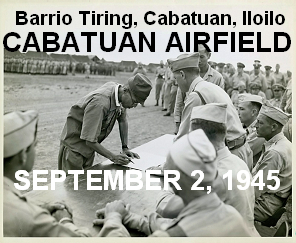
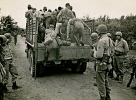

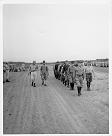


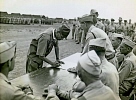
Col. Ryoichi Tozuka signs the surrender instrument
as Col. Raymond G. Stanton looks on.
Cabatuan Airfield
Barrio Tiring, Cabatuan, Iloilo
Panay Island, Philippines, September 2, 1945
|
|
- o -
|
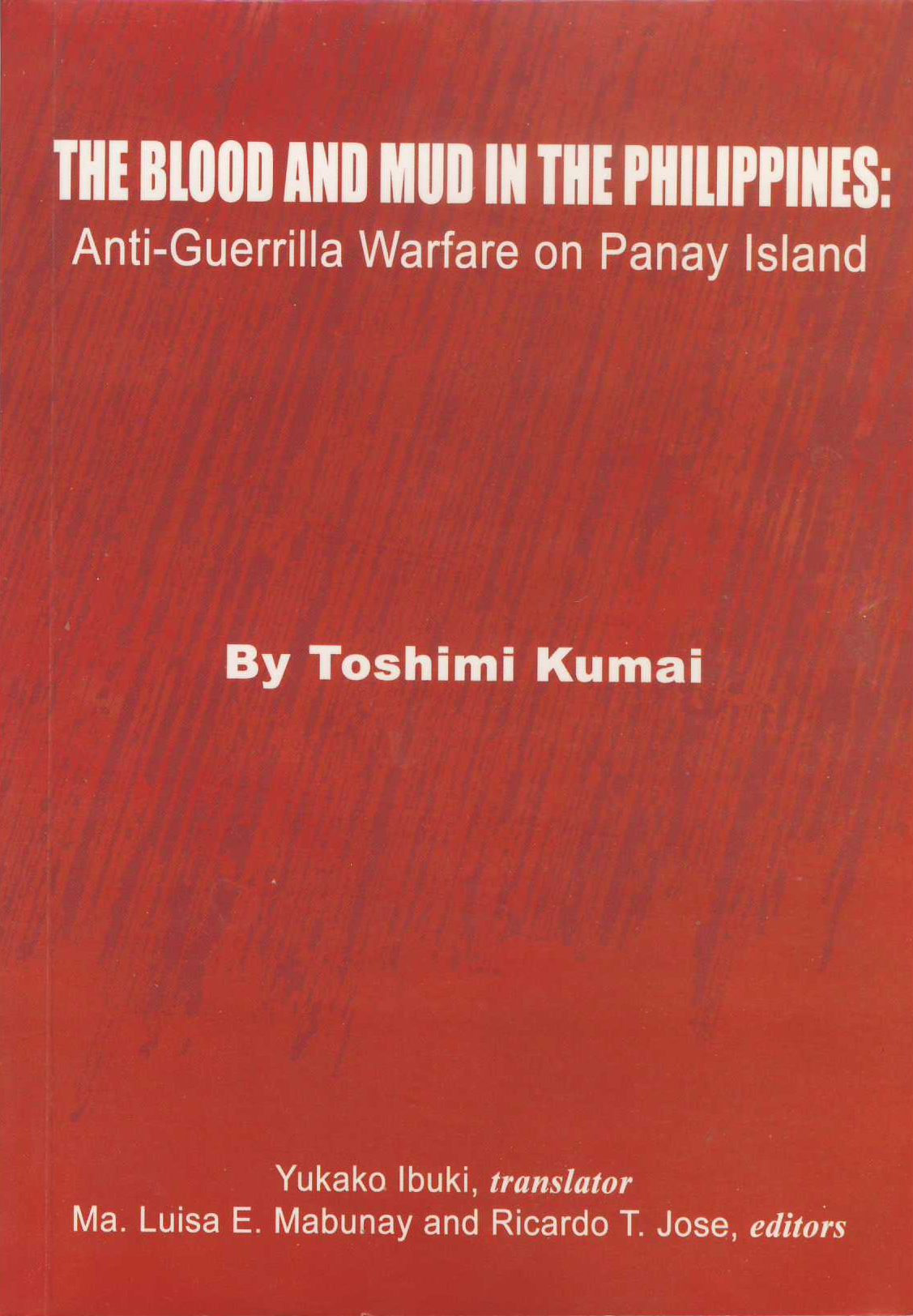
The Blood and Mud in the Philippines
Anti-Guerrilla Warfare on Panay Island
by Toshimi Kumai
Yukako Ibuki, translator
Ma. Luisa E. Mabunay and Ricardo T. Jose, editors
|
|
Chapter 10 – Surrender
10.1 Army Messenger
Around that time, news from the United States after the occupation of Okinawa was all about the bombings of Japan proper. We also learned of the surrender of Germany from the US military leaflets that said ‘A black cloud has come to the East’. With the start of the rainy season, the mood at the Bocari position was gloomy. Each unit held variety shows to liven up the atmosphere.
While we tried to adapt, the lack of food and salt became a serious issue. In search of food, we had to go further and further away from our positions. Sometimes, these forays involved encounters with the Philippine Constabulary. The rainy season also made it difficult to collect food. On August 13, ‘Corporal Nakagami of the wireless radio squad reported, ‘US broadcast says Japan has made a request of the Allies through Switzerland that she would surrender without conditions.’ I gave a strict order not to tell anybody, and to carefully listen to the news on the following days.
Then, the Emperor’s broadcast of unconditional surrender on August 15 came. I myself listened with the receiver on my ears and immediately reported the news to Colonel Tozuka. He quickly assembled the company commanders and told them the news. Instead of grieving over the surrender, the whole atmosphere at Bocari regained brightness. The faces of the soldiers of relief and the joy of liberation. That night each unit got out the best preserved foodstuffs and ate to their hearts’ content. The Japanese Army in Panay was at last going to be relieved of the day and night combat that they had endured for more than three years.
On that same day, however, our only communications engineer Corporal Takada of the headquarters’ wireless squad went missing when he left to look for food. The last news of him was that he got embroiled in a fight with soldiers at a village. He was killed in battle on the day the war ended to become the last of the unit’s casualties of the war in Panay.
With news of the surrender, the unit regained cheerfulness and some talked of returning to Japan. Nonetheless, there were also some voices fearing retaliation for atrocities committed by us on Filipinos. I myself was concerned about the clause in the Potsdam Declaration that said that those who killed or maltreated Allied POW and non-combatants would be tried at court. I asked Colonel Tozuka about it and he just laughed saying that it was meant for those who committed awful slaughter, and therefore, had nothing to do with us.
The Kempeitai commander, Captain Kaneyuki Koike, got out manual of the Army Criminal Law and opened to the pages near the end of the book. He went through the international agreements and read aloud the important articles based on the Geneva Convention on the treatment of POWs. Though I had heard of the existence of such agreements, it was the first time I heard about their content. I could not satisfy myself by just listening to them. Consequently, I read the articles on my own to the extent that I was able to talk to others about them. Colonel Tozuka then prohibited everyone from leaving his assigned position, not even a single step. He especially warned everyone not to have any conflicts with local residents.
We expected that some instructions would come from the US forces. On August 24 or 25, a US observation plane flew over Bocari, as though looking for us. We spread a signaling panel and sent signals to the US plane. Recognizing the signaling panel, the plane’s body swung left and right and dropped a communication tube. Inside were instructions of the date and place where a representative of the Japanese Army was to proceed. There was also a written order signed by staff officer Hidemi Watanabe (then in Negros), which said, ‘By the order of General Yamashita, commander of the 14th Area Army, the Japanese Army should obey the instructions given by the US forces in your locality. On the next day, the observation plane flew back. When we signaled the reply, ‘We have understood the instructions,’ the plane dropped a walkie-talkie (transceiver) to be used for contact.
That day, the unit commanders’ meeting decided that, as previously planned, the Japanese Army emissaries would be Captain Koike of the Kempeitai, 1st Lieutenant Ishikawa and I, with Sergeant Matsuzaki as the interpreter. The NCO cadet platoon led by 1st Lieutenant Horimoto, with Private First Class Ueki as the interpreter, would accompany us as our escort.
Early in the morning of August 30, the emissaries of the Japanese Army in Panay, Captain Koike, 1st Lieutenant Ishikawa and I, climbed down from Bocari and walked towards the town of Maasin. Moving in front, Private First Class Ueki carried a big white flag. As we advanced, the observation plane came to meet us. Sergeant Matsuzaki kept in touch using the walkie-talkie. The mountain path widened to a road along the river as it was nearly the set time of our arrival at the appointed place. As we advanced, we were expecting some contact from the US forces. Suddenly, seven or eight gigantic American soldiers came out of the jungle and surrounded us.
With a smile on his face, a gentle-looking officer of around 34 or 35 years of age told me that they had come to meet us. He was wearing the insignia of a major. The Major walked cheerfully along with me, as if he were escorting a group of children. As we moved along the river, the jungle came to an abrupt end and the surroundings suddenly became bright. We were at Daja, the reservoir of Iloilo City’s water supply. Immediately, a dozen news cameras positioned in front of us started to roll. Some American soldiers who surrounded us also clicked the shutters of their cameras. The extraordinary scene that all of a sudden materialized took us all aback. All the American soldiers before us were full of joy and the scene was like that of a festival.
Our escorting NCO platoon stood by while the four of us – Captain Koike, 1st Lieutenant Ishikawa, I, and the interpreter Sergeant Matsuzaki – were placed on jeeps. I rode with a battalion commander with a platoon of US soldiers guarding our front and back. Our jeeps ran through the forest, and in about five minutes, we could see houses of local residents. Citizens who recognized us came rushing towards the vehicles, following us while shouting all sorts of curses in anger – ‘bakayaro,’ ‘dorobo’ (stupid, thief). Some raised their fists, some mimicked beheading with their hands, and a raging crowd surrounded us. The jeering reached its height as our jeeps arrived at Maasin plaza.
At an open space of about 150 square meters, heavy machine guns were set at all directions while around a battalion of soldiers were on strict watch. As if waiting for a theatrical performance around the plaza, hundreds of local people stayed for the start of the meeting between the Japanese Army emissaries and the representatives of American forces. After the four of us were body-checked, the battalion commander escorted us to a table positioned at the center of the plaza. At the center of the table sat a dignified colonel of around 45 or 46 years old. Along with three or four more young officers, a shrewd-looking young Lieutenant Colonel sat on his left and a major of around 50 years of age sat on his right. Behind them stood the bearers of the US and the regimental flags while around 20 colossal soldiers surrounded them in a half circle.
Only the young Lieutenant Colonel on the US side and myself on the Japanese side attended to the technical details related to the surrender. Having experienced the acceptance of POWs at the capture of Bataan Peninsula, I replied in detail to questions such as the number of Japanese Army members, the number of patients, and weapons at Bocari. As a whole, the talk concluded smoothly, although there were a few points on which we did not agree.
During the discussion, I pointed out that we were shot at by Filipino soldiers and civilians on the way down to surrender and requested for a guarantee that such behavior would not be repeated in the future. The US side promised they would be responsible for our safety. I also asked for transport vehicles for all the Japanese soldiers secured by the American forces as well as special transport and hospitalization for the patients. To our surprise, they readily accepted these requests without hesitation. For 100 headquarters officers and the rest of the unit, the agreed date of surrender was September 1. The surrender of the Saitô unit was to follow on September 2.
Colonel R.G. Stanton (commanding officer of the 160th Infantry Regiment) signed the instrument of surrender on the US side, and Captain Koike on the Japanese side. Just when the signing was finished, it suddenly became calm. With the command, ‘Ten hut!’ Colonel Stanton and the others all stood up and saluted. As we turned together and saluted, we saw a noble Major General of around 50 years of age, who had a face like a young boy, followed by his staff. He was smiling contentedly and repeatedly returned our salute. A Japanese-American interpreter standing close to me whispered it was the 40th Division Commander, Major General Rapp Brush.
We ended the meeting with our request to give the surrender instructions to the Saitô unit. On the way back, the people along the road kept shouting but I noticed their faces were full of joy as they must have known of the surrender of the Japanese Army. On our way back to the mountains, the US observation plane saw us off from above but we did not hear any gunshots.
We reached the Bocari headquarters around 3 p.m. Colonel Tozuka and other commanders were eagerly waiting for our return.
The three of us immediately reported to them the details of the meeting with the American forces and the disturbances made by the local people along the road on our way to and from the surrender site. We pointed out that the US forces were kind and courteous, more than we had expected. Alcoholic beverages made from corn were offered for celebration. The commanders immediately left without touching them, however, to tell their men of the developments. A joyous and relieved atmosphere soon filled the whole mountain of Bocari and the soldiers of the headquarters were excited like children going on an excursion. The officers and men of Panay were so exhausted that they could not afford to grieve for the defeat of their country.
|
|